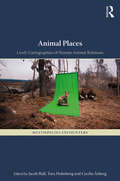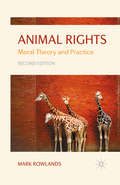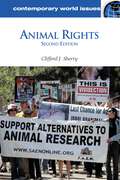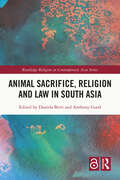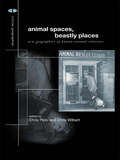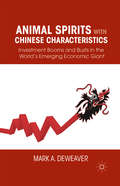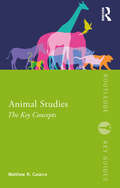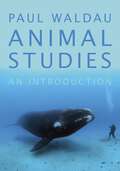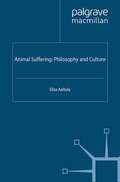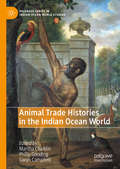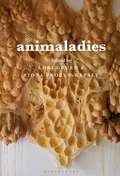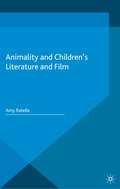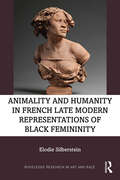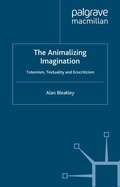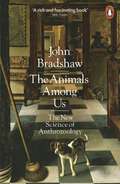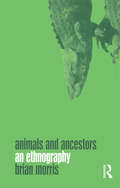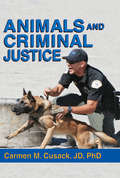- Table View
- List View
Animal Places: Lively Cartographies of Human-Animal Relations (Multispecies Encounters)
by Jacob Bull Tora Holmberg Cecilia ÅsbergNonhuman animals are ubiquitous to our ‘human’ societies. Interdisciplinary human/animal research has - for 50 years - drawn attention to how animals are ever-present in what we think of as human spaces and cultures. Our societies are built with animals and through all kinds of multispecies interactions. From public spaces and laboratories to homes, farms and in the ‘wilderness’; human and nonhuman animals meet to make space and place together, through webs of power relations. However, the very spaces of these interactions are not mute or passive themselves. The spaces where species meet matter, and shape human/animal relations. This book takes as its starting point the relationship between place and human/animal interaction. It brings together the work of leading scholars in human/animal studies, from a variety of disciplinary and interdisciplinary backgrounds. With a distinct focus on place, physical space and biocultural geography, the authors of this volume consider the ways in which space, human and nonhuman animals co-constitute each other, how they make spaces together, produce meaning around them, struggle over access, how these places are storied and how stories of spaces matter. Presenting studies thematically and including a variety of nonhuman creatures in a range of settings, this book delivers new understandings of the importance of nonhuman animals to understandings of place - and the role of places in shaping our interactions with nonhuman creatures. As pets, as laboratory animals, as exhibits, as parasites, as livestock, as quarry, as victims of disaster or objects of folklore, this book offers insights into human/animal intermingling at locales and settings of great relevance to many areas of research, including geography, sociology, science and technology studies, gender studies, history and anthropology. This book meets the evolving interest in human/animal interaction, anthrozoology, and the environmental humanities in relation to the research on space and place that currently informs the humanities and the social sciences.
Animal Rights: Moral Theory and Practice
by Mark RowlandsIn this 2nd edition the author has substantially revised his book throughout, updating the moral arguments and adding a chapter on animal minds. Importantly, rather than being a polemic on animal rights, this book is also a considered and imaginative evaluation of moral theory as explored through the issue of animal rights.
Animal Rights: A Reference Handbook (Contemporary World Issues)
by Clifford J. SherryThis revised edition helps readers understand and develop their own opinions on the fundamental issues, enduring controversies, and critical developments associated with animal rights.First published in 1994, Animal Rights: A Reference Handbook was widely acclaimed for its objective look at the ways in which humans treat animals. Extensively revised and updated, this new edition explores the basis for current perspectives on animal rights by addressing the relationship between humans and animals from scientific, philosophical, legal, and religious points of view.Animal Rights: A Reference Handbook, Second Edition maintains the balance and accessibility of the first edition, letting readers decide the bounds of human responsibility toward animals. It surveys a wide range of controversies surrounding the use of animals in such fields as the food industry, medical research, and the realm of entertainment, as well as the tremendous surge in scientific discoveries and technological advances that have led to new conversations on animal rights in the 21st century.
Animal Sacrifice, Religion and Law in South Asia (Routledge Religion in Contemporary Asia Series)
by Daniela Berti Anthony GoodThis book presents original research on the controversies surrounding animal sacrifice in South Asia through the lens of court cases. It focuses on the parties involved in these cases: on their discourses, motivations, and contrasting points of view. Through an examination of judicial files, court decisions and newspaper articles, and interviews with protagonists, the book explores how the question of animal sacrifice is dealt with through administrative, legislative, and judicial practice. It outlines how, although animal sacrifice has over the ages been contested by various religious reform movements, the practice has remained widespread at all levels of society, especially in certain regions. It reveals that far from merely being a religious and ritual question, animal sacrifice has become a focus of broader public debate, and it discusses how the controversies highlight the contrast between ‘traditional’ and ‘reformist’ understandings of Hinduism; the conflict between the core legal and moral principles of religious freedom and social progress; and the growing concern with environmental issues and animal rights.
Animal Sacrifice, Religion and Law in South Asia (Routledge Religion in Contemporary Asia Series)
This book presents original research on the controversies surrounding animal sacrifice in South Asia through the lens of court cases. It focuses on the parties involved in these cases: on their discourses, motivations, and contrasting points of view. Through an examination of judicial files, court decisions and newspaper articles, and interviews with protagonists, the book explores how the question of animal sacrifice is dealt with through administrative, legislative, and judicial practice. It outlines how, although animal sacrifice has over the ages been contested by various religious reform movements, the practice has remained widespread at all levels of society, especially in certain regions. It reveals that far from merely being a religious and ritual question, animal sacrifice has become a focus of broader public debate, and it discusses how the controversies highlight the contrast between ‘traditional’ and ‘reformist’ understandings of Hinduism; the conflict between the core legal and moral principles of religious freedom and social progress; and the growing concern with environmental issues and animal rights.
Animal Spaces, Beastly Places (Critical Geographies)
by Chris Philo Chris WilbertAnimal Spaces, Beastly Places examines how animals interact and relate with people in different ways. Using a comprehensive range of examples, which include feral cats and wild wolves, to domestic animals and intensively farmed cattle, the contributors explore the complex relations in which humans and non-human animals are mixed together. Our emotions involving animals range from those of love and compassion to untold cruelty, force, violence and power. As humans we have placed different animals into different categories, according to some notion of species, usefulness, domesticity or wildness. As a result of these varying and often contested orderings, animals are assigned to particular places and spaces. Animal Spaces, Beastly Places shows us that there are many exceptions and variations on the spatiality of human-animal spatial orderings, within and across cultures, and over time. It develops new ways of thinking about human animal interactions and encourages us to find better ways for humans and animals to live together.
Animal Spaces, Beastly Places (Critical Geographies)
by Chris Philo Chris WilbertAnimal Spaces, Beastly Places examines how animals interact and relate with people in different ways. Using a comprehensive range of examples, which include feral cats and wild wolves, to domestic animals and intensively farmed cattle, the contributors explore the complex relations in which humans and non-human animals are mixed together. Our emotions involving animals range from those of love and compassion to untold cruelty, force, violence and power. As humans we have placed different animals into different categories, according to some notion of species, usefulness, domesticity or wildness. As a result of these varying and often contested orderings, animals are assigned to particular places and spaces. Animal Spaces, Beastly Places shows us that there are many exceptions and variations on the spatiality of human-animal spatial orderings, within and across cultures, and over time. It develops new ways of thinking about human animal interactions and encourages us to find better ways for humans and animals to live together.
Animal Spirits with Chinese Characteristics: Investment Booms and Busts in the World’s Emerging Economic Giant
by M. DeWeaverWill China eventually be able to eliminate its socialist animal spirits? Highlighting the importance of China's investment booms and busts for both the Chinese and the world economy, Animal Spirits with Chinese Characteristics describes the origins and evolution of the investment cycle during the command economy period.
Animal Studies: The Key Concepts (Routledge Key Guides)
by Matthew R. CalarcoPrefaced with a brief introduction to the field of animal studies, the text explores the key influential terms, topics and debates which have had a major impact on the field, and that students are most likely to encounter in their animal studies classes. Animal Studies provides a guide to key concepts in the burgeoning interdisciplinary field of animal studies, laid out in A-Z format. While Human–Animal Studies and Critical Animal Studies are the main frameworks that inform the bulk of the writings in animal studies and the key concepts discussed in the volume, other approaches such as anthrozoology and cognitive ethology are also explored. The entries in the volume attend to the differences in ongoing debates among scholars and activists, showing that what is commonly called “animal studies” is far from a unified body of work. A full bibliography of sources is included at the end of the book, along with an extensive index. The book will be a valuable guide to undergraduate and postgraduate students in geography, philosophy, sociology, anthropology, women’s studies, and other related disciplines. Seasoned researchers will find the book helpful, when researching topics outside of their specialization. Outside of academia, it will be of interest to activists, as well as professional organizations.
Animal Studies: The Key Concepts (Routledge Key Guides)
by Matthew R. CalarcoPrefaced with a brief introduction to the field of animal studies, the text explores the key influential terms, topics and debates which have had a major impact on the field, and that students are most likely to encounter in their animal studies classes. Animal Studies provides a guide to key concepts in the burgeoning interdisciplinary field of animal studies, laid out in A-Z format. While Human–Animal Studies and Critical Animal Studies are the main frameworks that inform the bulk of the writings in animal studies and the key concepts discussed in the volume, other approaches such as anthrozoology and cognitive ethology are also explored. The entries in the volume attend to the differences in ongoing debates among scholars and activists, showing that what is commonly called “animal studies” is far from a unified body of work. A full bibliography of sources is included at the end of the book, along with an extensive index. The book will be a valuable guide to undergraduate and postgraduate students in geography, philosophy, sociology, anthropology, women’s studies, and other related disciplines. Seasoned researchers will find the book helpful, when researching topics outside of their specialization. Outside of academia, it will be of interest to activists, as well as professional organizations.
Animal Studies: An Introduction
by Paul WaldauAnimal studies is a growing interdisciplinary field that incorporates scholarship from public policy, sociology, religion, philosophy, and many other areas. In essence, it seeks to understand how humans study and conceive of other-than-human animals, and how these conceptions have changed over time, across cultures, and across different ways of thinking. This interdisciplinary introduction to the field boldly and creatively foregrounds the realities of nonhuman animals, as well as the imaginative and ethical faculties that humans must engage to consider our intersection with living beings outside of our species. It also compellingly demonstrates that the breadth and depth of thinking and humility needed to grasp the human-nonhuman intersection has the potential to expand the dualism that currently divides the sciences and humanities. As the first holistic survey of the field, Animal Studies is essential reading for any student of human-animal relationships and for all people who care about the role nonhuman animals play in our society.
Animal Studies: An Introduction
by Paul WaldauAnimal studies is a growing interdisciplinary field that incorporates scholarship from public policy, sociology, religion, philosophy, and many other areas. In essence, it seeks to understand how humans study and conceive of other-than-human animals, and how these conceptions have changed over time, across cultures, and across different ways of thinking. This interdisciplinary introduction to the field boldly and creatively foregrounds the realities of nonhuman animals, as well as the imaginative and ethical faculties that humans must engage to consider our intersection with living beings outside of our species. It also compellingly demonstrates that the breadth and depth of thinking and humility needed to grasp the human-nonhuman intersection has the potential to expand the dualism that currently divides the sciences and humanities. As the first holistic survey of the field, Animal Studies is essential reading for any student of human-animal relationships and for all people who care about the role nonhuman animals play in our society.
Animal Suffering: Philosophy and Culture (The Palgrave Macmillan Animal Ethics Series)
by E. AaltolaExploring how animal suffering is made meaningful within Western ramifications, the book investigates themes such as skepticism concerning non-human experience, cultural roots of compassion, and contemporary approaches to animal ethics. At its center is the pivotal question: What is the moral significance of animal suffering?
Animal Trade Histories in the Indian Ocean World (Palgrave Series in Indian Ocean World Studies)
by Martha Chaiklin Gwyn Campbell Philip GoodingThis book examines trades in animals and animal products in the history of the Indian Ocean World (IOW). An international array of established and emerging scholars investigate how the roles of equines, ungulates, sub-ungulates, mollusks, and avians expand our understandings of commerce, human societies, and world systems. Focusing primarily on the period 1500-1900, they explore how animals and their products shaped the relationships between populations in the IOW and Europeans arriving by maritime routes. By elucidating this fundamental yet under-explored aspect of encounters and exchanges in the IOW, these interdisciplinary essays further our understanding of the region, the environment, and the material, political and economic history of the world.
Animaladies: Gender, Animals, and Madness
by Carol J. Adams Professor Lori Gruen Professor Fiona Probyn-RapseyDo depictions of crazy cat ladies obscure more sinister structural violence against animals hoarded in factory farms?Highlighting the frequent pathologization of animal lovers and animal rights activists, this book examines how the "madness†? of our relationships with animals intersects with the "madness†? of taking animals seriously. The essays collected in this volume argue that "animaladies†? are expressive of political and psychological discontent, and the characterization of animal advocacy as mad or "crazy†? distracts attention from broader social unease regarding human exploitation of animal life.While allusions to madness are both subtle and overt, they are also very often gendered, thought to be overly sentimental with an added sense that emotions are being directed at the wrong species. Animaladies are obstacles for the political uptake of interest in animal issues-as the intersections between this volume and established feminist scholarship show, the fear of being labeled unreasonable or mad still has political currency.
Animaladies: Gender, Animals, and Madness
by Lori Gruen Carol J. Adams Fiona Probyn-RapseyDo depictions of crazy cat ladies obscure more sinister structural violence against animals hoarded in factory farms?Highlighting the frequent pathologization of animal lovers and animal rights activists, this book examines how the “madness” of our relationships with animals intersects with the “madness” of taking animals seriously. The essays collected in this volume argue that “animaladies” are expressive of political and psychological discontent, and the characterization of animal advocacy as mad or “crazy” distracts attention from broader social unease regarding human exploitation of animal life.While allusions to madness are both subtle and overt, they are also very often gendered, thought to be overly sentimental with an added sense that emotions are being directed at the wrong species. Animaladies are obstacles for the political uptake of interest in animal issues-as the intersections between this volume and established feminist scholarship show, the fear of being labeled unreasonable or mad still has political currency.
Animality and Children's Literature and Film (Critical Approaches to Children's Literature)
by A. RatelleExamining culturally significant works of children's culture through a posthumanist, or animality studies lens, Animality and Children's Literature and Film argues that Western philosophy's objective to establish a notion of an exclusively human subjectivity is continually countered in the very texts that ostensibly work to this end.
Animality and Humanity in French Late Modern Representations of Black Femininity (Routledge Research in Art and Race)
by Elodie SilbersteinThis volume examines the evolution of the depictions of black femininity in French visual culture as a prism through which to understand the Global North’s destructive relationship with the natural world. Drawing on a broad spectrum of archives extending back to the late 18th century – paintings, fashion plates, prints, photographs, and films – this study traces the intricate ways a patriarchal imperialism and a global capitalism have paired black women with the realm of nature to justify the exploitation both of people and of ecosystems. These dehumanizing and speciesist strategies of subjugation have perpetuated interlocking patterns of social injustice and environmental depletion that constitute the most salient challenges facing humankind today. Through a novel approach that merges visual studies, critical race theory, and animal studies, this interdisciplinary investigation historicizes the evolution of the boundaries between human and non-human animals during the modern period. The book will be of interest to scholars working in art history, visual studies, critical race theory, colonial and post-colonial studies, animal studies, and French studies.
Animality and Humanity in French Late Modern Representations of Black Femininity (Routledge Research in Art and Race)
by Elodie SilbersteinThis volume examines the evolution of the depictions of black femininity in French visual culture as a prism through which to understand the Global North’s destructive relationship with the natural world. Drawing on a broad spectrum of archives extending back to the late 18th century – paintings, fashion plates, prints, photographs, and films – this study traces the intricate ways a patriarchal imperialism and a global capitalism have paired black women with the realm of nature to justify the exploitation both of people and of ecosystems. These dehumanizing and speciesist strategies of subjugation have perpetuated interlocking patterns of social injustice and environmental depletion that constitute the most salient challenges facing humankind today. Through a novel approach that merges visual studies, critical race theory, and animal studies, this interdisciplinary investigation historicizes the evolution of the boundaries between human and non-human animals during the modern period. The book will be of interest to scholars working in art history, visual studies, critical race theory, colonial and post-colonial studies, animal studies, and French studies.
The Animalizing Imagination: Totemism, Textuality and Ecocriticism
by A. BleakleyAnimals appear not just as biological creatures, but as vehicles of meaning for human imagination, mind and culture. Animal life may form the basis for an animalizing imagination that can enhance our cultural, religious and aesthetic sensibilities. This imagination is rooted in the pre-modern affective relationship between shamans and their familiars, but can be tracked to our post-modern ecological crisis, where we can reclaim a totemic identification with animals as signifiers of a new ecological understanding.
The Animals Among Us: The New Science of Anthrozoology
by John Bradshaw'A pioneering study ... richly, empathetically and affectionately respectful of the human-animal bond' Sunday TimesWhy do humans love animals? The bestselling author of In Defence of Dogs and Cat Sense gives us the answers.Keeping pets is expensive, time-consuming, and seemingly irrational - so why do so many of us have an animal in our lives?Modern-day pet-keeping has been justified for many reasons, from the potential therapeutic role pets can play, to their appealing 'cuteness'. But pet-keeping is much more than just a simple pastime. It is part of the broader history of humanity's relationship with animals - a relationship that comes from deep within our nature. As John Bradshaw reveals in this highly original new work, our connection with animals is one of the very things that makes us human. In The Animals Among Us, Bradshaw takes us to the heart of Anthrozoology, a new science dedicated to discovering the true nature and depth of the human-animal bond. Following the thread of our affection for animals, from today's pet lovers all the way back to our ancient ancestors, Bradshaw reveals how animals have always been an integral part of our lives: indeed, they have shaped the evolution of our minds and our bodies. The ways in which we relate to animals today stem ultimately from our evolutionary journey from hominid to Homo sapiens.An affinity for animals drove our evolution as humans. Now, as increasing numbers of species are under threat, John Bradshaw shows us that pet-keeping can act as a bridge between the domestic and the wild, even aiding conservation. If we lose the animals among us, he warns, we risk losing an essential part of ourselves.
Animals and African Ethics (The Palgrave Macmillan Animal Ethics Series)
by Kai HorsthemkeThe claim is frequently made on behalf of African moral beliefs and practices that they do not objectify and exploit nature and natural existents like Western ethics does. This book investigates whether this is correct and what kind of status is reserved for other-than-human animals in African ethics.
Animals and Ancestors: An Ethnography
by Brian MorrisEver since the emergence of human culture, people and animals have co-existed in close proximity. Humans have always recognized both their kinship with animals and their fundamental differences, as animals have always been a threat to humans' well-being. The relationship, therefore, has been complex, intimate, reciprocal, personal, and -- crucially -- ambivalent. It is hardly surprising that animals evoke strong emotions in humans, both positive and negative. This companion volume to Morris' important earlier work, The Power of Animals, is a sustained investigation of the Malawi people's sacramental attitude to animals, particularly the role that animals play in life-cycle rituals, their relationship to the divinity and to spirits of the dead. How people relate to and use animals speaks volumes about their culture and beliefs. This book overturns the ingrained prejudice within much ethnographic work, which has often dismissed the pivotal role animals play in culture, and shows that personhood, religion, and a wide range of rituals are informed by, and even dependent upon, human-animal relations.
Animals and Ancestors: An Ethnography
by Brian MorrisEver since the emergence of human culture, people and animals have co-existed in close proximity. Humans have always recognized both their kinship with animals and their fundamental differences, as animals have always been a threat to humans' well-being. The relationship, therefore, has been complex, intimate, reciprocal, personal, and -- crucially -- ambivalent. It is hardly surprising that animals evoke strong emotions in humans, both positive and negative. This companion volume to Morris' important earlier work, The Power of Animals, is a sustained investigation of the Malawi people's sacramental attitude to animals, particularly the role that animals play in life-cycle rituals, their relationship to the divinity and to spirits of the dead. How people relate to and use animals speaks volumes about their culture and beliefs. This book overturns the ingrained prejudice within much ethnographic work, which has often dismissed the pivotal role animals play in culture, and shows that personhood, religion, and a wide range of rituals are informed by, and even dependent upon, human-animal relations.
Animals and Criminal Justice
by Carmen M. CusackMahatma Gandhi said, "The greatness of a nation and its moral progress can be judged by the way its animals are treated." Since civil societies are ruled by law, they can be evaluated, both figuratively and literally, by how animals are treated in the criminal justice system. This book depicts animals' roles within society and the laws that govern how humans treat them. Carmen M. Cusack focuses on current issues in human-animal relationships and how these are affected by the criminal justice system. Her analysis, while objective, is rooted in first-hand activist, professional, legal, and criminal justice experience. She presents a comprehensive overview of the place of animals and the law, including pets in prison, K-9 units, constitutional rights, animal sacrifice, wild animals, entertainment, domestic violence, rehabilitation, history, and religion. She includes information about law, behavioural and social science, systemic responses and procedure, anecdotal evidence, current events, and theoretical considerations. Animals and Criminal Justice is a useful handbook and a thorough textbook, as well as a practical guide to animals' relationships with the criminal justice system. Professionals, including police, child protective services, judges, animal control officers, and corrections staff, as well as scholars in the fields of criminal justice and criminology will find this book invaluable.
